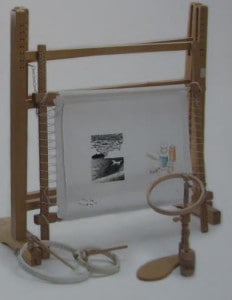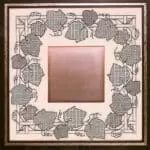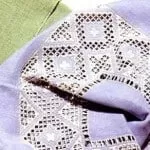What do you need for blackwork? Materials:

Materials
To work a piece of blackwork embroidery there are some fundamental tools and materials that you will need. It is key to work on a good quality, evenweave fabric in a sturdy embroidery frame, and, as well as the fabric,
you will also need a good range o f thread thicknesses.
FRAMES
A good sturdy frame is always key in any embroidery project as it is essential that the fabric maintains a tight tension throughout.Ring frames are suitable for smaller, short projects, and are very convenient to use. To keep the fabric tight in this style o f frame, a good tip is to bind one o r both rings with a strip o f thin cotton or webbing
before you place the fabric inside, as this will prevent it loosening is you work. Once the fabric is placed inside the ring, tighten with a screwdriver and gendy ease the fabric o u t all the way round. As you work on the piece, you will find you need to re-tighten the fabric now and again to keep it to a drum -like tension.
It is also advisable to remove the fabric each time you stop working to discourage a ring m ark forming around the edge. T he ring frame can be attached to a barrel clamp on a table, a seat clamp o r a floor stand, all
o f which give you the freedom to stitch with both hands and allow you m ore control. Remember to cover your work with acid-free tissue paper to keep it clean. T h e alternative to a ring frame is called a slate frame, which is used for
larger, longer-term projects. It is made up o f two rollers and two arms, which, when placed together, form a structure in which your fabric is tightly stretched. The rollers enable you to have a much bigger piece o f
fabric, which is turned out as you need it. T h e beauty o f this frame is that your fabric is completely flat and it is much easier to see w hat you are working on (see below), while maintaining a good tension.The frame
rests on top o f trestles, which you can comfortably sit at to stitch.
THREADS AND NEEDLES
T h o u g h silk was the traditional choice o f thread for blackwork, embroiderers today also use cotton. T he most widely used is stranded cotton, oа which you can apply between one and six strands.You can also use co to n a bro d er no. 16, which is a thick, soft, twisted cotton for denser stitching, o r a very fine no. 50 machine thread, which is ideal for lighter tonal values.Varying thicknesses o f very fine silk gossamer are also available and are used to create even finer delicate patterns.It is good to have a range o f threads, as this w ill give you m ore
variety w hen shading, and as long as die thread passes smoothly though the holes in the fabric, there are noitadons.
By tradition, metal threads and spangles were also used to highlight and en rich areas of a blackwork design. Today these can include, stranded metallic threads, o r metallic machine threads, which can be used in the needle to stitch the patterns o r to define outlines. Spangles are like sequins b u t are finely cu t pieces o f metal from a tightly coiled
wire. These can be used to create pattern in the background to form a little speck o f highlight.Other essential threads include strong button thread for framing up in a slate frame and a cotton tacking thread for transferring the design.Tapestry needles are used w hen working any counted embroidery technique, including blackwork. T he needle should pass with ease through the holes in the evenweave linen without forcing the grain to
separate too much. Having a blunt end ensures that none of the fibres f the fabric are caught. The size of needle largely depends on the gauge o f fabric, so the thickness of the needle should be approximately the thickness o f o n e o f the grains o f linen, for example, a 35-count linen would need a no. 24 o r no. 26 tapestry needle.T here are occasions in blackwork where a sharp embroidery needle is required. At any point where you are piercing the grain o f the fabric to create an outline o r stitching down a spangle, a sharp needle is key. A good all-round size is a no. 9 o r no. 10 embroidery needle, however if you are using a thicker cotton a broder thread, then a no. 7 is better.
The lower the number, the thicker the needle.A large bracing needle is required when framing up in a slate frame, this is to thread the parcel string in to in order to stretch the fabric or tight
FABRIC
Blackwork is always worked on an even weave fabric, this means that the warp and weft have the same number o f
threads per inch (TPI) and although natural slubs may appear, the fabric is even and easy to count.
The TPI will determine the scale o f each stitch you do within a blackwork diaper pattern, so it is very important to
choose the scale that suits your design.For a very detailed embroidery o r small design, a 35 TPI Edinburgh linen works well, o r for a large scale design, something like 20 TPI Cork linen.Other counts o f linen include 2 5 ,2 8 ,3 2 and 40TPI. The higher the number, the finer the fabric, and so the smaller the stitches will be.
See also free blackwork patterns
You also may like : Hardanger embroidery










